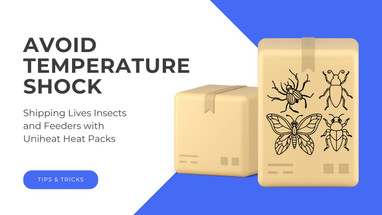Posted by UniHeatPacks on 27th Oct 2025
Shipping Live Insects & Feeders Without Temperature Shock
Preventing temperature shock is the single most important factor in live-insect shipping. Because insects are ectothermic, their metabolism relies on the ambient environment—sudden cold or heat during transit can cause stress, inactivity, or loss. This guide explains how to ship feeder insects (crickets, mealworms, dubia roaches, superworms, etc.) safely by creating a stable microclimate with smart packaging, ventilation, and the right UniHeat shipping warmers.
1) Why Temperature Shock Happens in Transit
Packages move between climate-controlled interiors and unregulated hubs, trucks, or porches. When internal temps swing below ~50°F, insects slow dramatically and risk dehydration; above ~90°F, oxygen demand rises while enclosed air can dry out or overheat. The goal is not to make the box hot—it’s to keep it consistent.
- Cold exposure: Sorting hubs, cargo holds, and overnight stops can drop temps quickly.
- Heat exposure: Sunlit vehicles/facilities can spike temps even in mild seasons.
- Long routes: Multi-day shipping increases exposure to unpredictable conditions.
2) The Science of Heat Retention Inside the Box
Insulation slows heat transfer by trapping air (a natural insulator). Gentle airflow remains essential because insects require oxygen and UniHeat packs are oxygen-activated. Balance is key:
- Insulation: Foam liners or thermal pads buffer against rapid external swings.
- Air space: A modest air gap allows warmth to circulate without drafts.
- Ventilation: Small vents sustain both insect respiration and warmer activity.
Pro Tip: Think “steady and breathable.” Extreme heat is as risky as extreme cold. Design the box to avoid hot spots and cold corners—stability wins.
3) How UniHeat Warmers Create Controlled Warmth
UniHeat warmers generate consistent heat through controlled oxidation (iron + oxygen). Unlike “instant” hand warmers that spike and fade, UniHeat packs are engineered for live shipments—steady output over known timeframes:
- 20–40 Hour Warmers: Overnight or short-haul routes in mild to cool weather.
- 60–72 Hour Warmers: Most 2–3 day routes; ideal baseline for winter ground/priority.
- 96 Hour Mega Warmers: Extreme cold snaps, rural routes, or delay-prone corridors.
Each warmer lists activation steps and duration. Match the warmer length to your route + weather, not just carrier estimates.
4) Packaging to Prevent Temperature Shock
Follow these best practices to maintain a stable microclimate and protect insect welfare:
- Insulated shipper: Use a foam-lined carton or insulated liner. Double-box for severe cold.
- Place the warmer correctly: Tape to an inner wall or lid, never directly touching insects.
- Breathable containers: Use vented cups/mesh; add paper or egg crate for clinging space.
- Create an air gap: Avoid over-stuffing; allow gentle circulation across the interior.
- Seasonal adjustments: In heat, reduce insulation and consider cool packs (never freeze).
Pro Tip: Activate UniHeat warmers 20–30 minutes before sealing the box. This ensures they’re breathing and at steady output when the package enters the carrier network.
5) Choosing the Right UniHeat Warmer
| Warmer | Duration | Best Use |
|---|---|---|
| UniHeat 40-Hour Shipping Warmer | Up to 40 hours | Short routes; mild conditions; overnight flights |
| UniHeat 72-Hour Shipping Warmer | Up to 72 hours | Most 2–3 day winter routes; national ground/priority |
| UniHeat 96-Hour Mega Warmer | Up to 96 hours | Extreme cold; remote destinations; delay-prone corridors |
Browse the full line at UniHeat.us and select durations based on route time + forecast, not just the carrier’s estimate.
Frequently Asked Questions
What temperature range is generally safe for shipping feeder insects?
Most species ship well when the interior stays roughly 70–85°F. Below ~60°F, activity slows and risk rises; above ~90°F, oxygen demand increases and dehydration can occur. Target a steady mid-range, not highs.
Do I need ventilation holes in an insulated shipper?
Yes. Add 2–4 pencil-size vent holes in the outer box only. This sustains UniHeat oxidation and insect respiration without creating drafts. Avoid venting the inner foam liner.
Can multiple warmers be used together?
Yes for large boxes or multi-compartment loads. Space warmers apart and test placement to prevent hot spots. Several smaller warmers often distribute heat more evenly than a single oversized unit.
How do UniHeat warmers differ from hand warmers?
Hand warmers often peak quickly and can run too hot for live shipments. UniHeat warmers are tuned for consistent, moderated output over long durations—safer for temperature-sensitive cargo.
What’s the best way to position insects relative to the warmer?
Keep insects central and off direct contact. Tape the warmer to an inner wall or lid with a cardboard spacer; maintain an air gap so warmth circulates evenly.
About UniHeat: Since 1996, UniHeat has been the trusted name in animal, plant, and perishable shipping. Our oxygen-activated warmers deliver safe, consistent heat across climates. Explore the full range at UniHeat.us.

